Bluemoon
|
| posted on 31/1/10 at 05:12 PM |

|
|
Garage floor damp any short term solutions (now with photos)?
Hi all,
Long story but we are living in a tide house (i.e. comes with my wife's job as a curate) for about 18 more months. The garage is an old marly
concrete one and the end of the garden.
Snag is the garage was damp, so as part of taking the position we had roof replaced, as the roof had gone porous. This was done, and during the summer
all was o.k.
Now it's cold and wet the damp has returned at the door end and far end around about 1m in at each end (better than it was). And stuff is going
moldy, including the new roof (and hopefully not the MK's leather seats!).
I think the damp is mainly rising damp and possibly runing in a the door end.
The concrete floor is cracked due to nearby tree roots and this is in the area where the floor is wet. (I guess the damp proof membrane is also
cracked).
One problem is that the replacement roof does not allow for ventilation (the old was open at the ends), so once it is damp it will not dry out..
My initial thoughts are:
1) Cover floor in rubber floor from bigdug (~£66) to stop rising damp, by acting as a vapour barrier.
2) put a batton under the mat near the door to stop water coming in that way.
3) get a de-humidifier that works on a humid-stat.
I can then take the floor mat and de-humidifier way for the next place.
What do you think? Good idea? Or is there something else I should do?
Dan
Some photos of the problem:
Door end:
 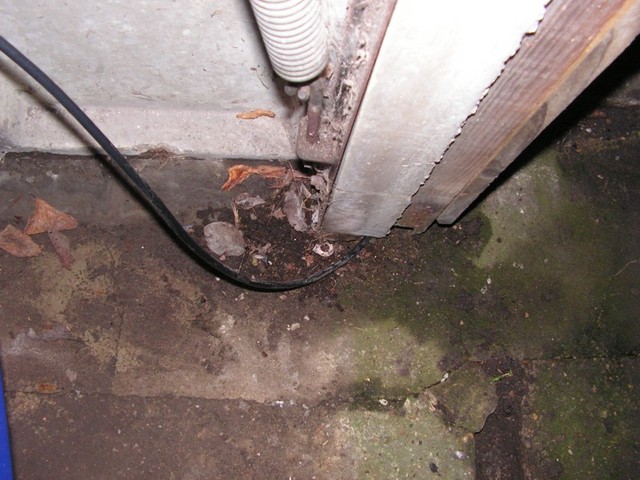
Door end damp 1
 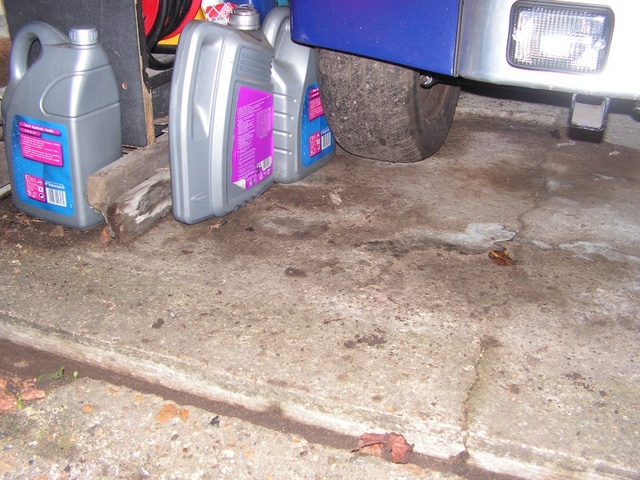
Door end damp 2
Side damp (not a lot):
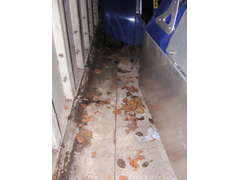 
Side damp
End damp (furthest from door):
 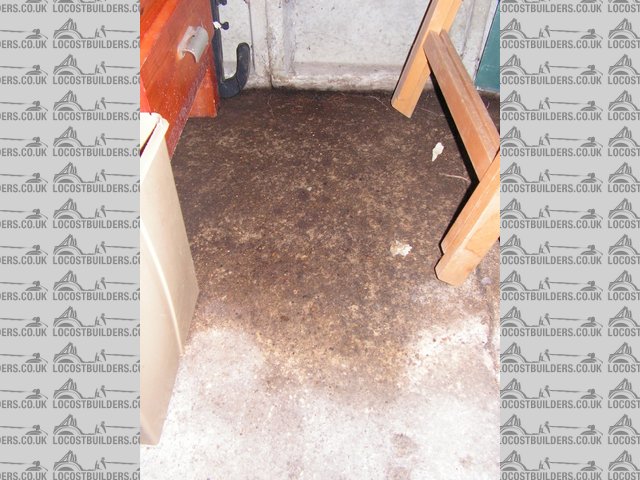
Far end damp
Mold on roof:
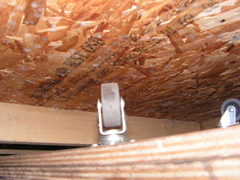 
Mold on roof
[Edited on 31/1/10 by Bluemoon]
[Edited on 31/1/10 by Bluemoon]
[Edited on 31/1/10 by Bluemoon]
|
|
|
|
|
zilspeed
|
| posted on 31/1/10 at 05:17 PM |

|
|
Can we see some pictures ?
The pattern and colour of the dampness tells a great deal about the source and possibly the cure too.
Short video carefully shot to avoid showing all your valuables would be even more helpfull.
|
|
|
will121
|
| posted on 31/1/10 at 05:19 PM |

|
|
would say if things are going moldy its due to lack of ventillation, if you are ok with dry but cold then would add some vents back, also if its stale
damp air i would watch the leather as just looken in my track day fiesta first time in a month and the stering wheel was covered in mold
|
|
|
zilspeed
|
| posted on 31/1/10 at 05:25 PM |

|
|
quote:
Originally posted by will121
would say if things are going moldy its due to lack of ventillation, if you are ok with dry but cold then would add some vents back, also if its stale
damp air i would watch the leather as just looken in my track day fiesta first time in a month and the stering wheel was covered in mold
That's why I would want to see pics before saying anything more. Many times, the defect gets attributed to rising damp. It can often be dealt
with exactly as you say by sorting out ventilation.
Remember, mould on items within the space is down to excess moisture within the atmosphere, which may or may not be coming from the building fabric.
|
|
|
Bluemoon
|
| posted on 31/1/10 at 05:29 PM |

|
|
quote:
Originally posted by zilspeed
Can we see some pictures ?
The pattern and colour of the dampness tells a great deal about the source and possibly the cure too.
Short video carefully shot to avoid showing all your valuables would be even more helpfull.
Not yet I'll take some and update the post..
|
|
|
will121
|
| posted on 31/1/10 at 06:15 PM |

|
|
looking a photos, is it general water ingress at base/door, these sectional garages generally just bolt to slab with a basic cement fillet, whats the
ground level like outside does water sit up against base? would then say this small water ingress is then making the garage damp combined with limited
ventillation leading to mold
|
|
|
BenB
|
| posted on 31/1/10 at 06:25 PM |

|
|
I'd try force drying the floor then painting it with some nice gloopy concrete paint. It could just be the floor has gone porous and the water
soaking into it is evaporating resulting in high humidity.
Worth a try at £20 a tin....
|
|
|
Bluemoon
|
| posted on 31/1/10 at 06:28 PM |

|
|
quote:
Originally posted by will121
looking a photos, is it general water ingress at base/door, these sectional garages generally just bolt to slab with a basic cement fillet, whats the
ground level like outside does water sit up against base? would then say this small water ingress is then making the garage damp combined with limited
ventillation leading to mold
At the back of the garage the soil is about ~18" above the base! It was the same around one side I have dug a trench around the base (to about
1m of the back of the garage, where there is a tree and it's roots go under the base, no way can i dig it out, and if I do I bet the base will
start moving as the roots rot!).
The trench dug to the bottom of the base and I have now back filed with gravel to level with the base top to help with the drainage (which is really
bad for standing water, I guess because of the high water table).
Around the back is part of a drive (not ours) so I can't really dig this out simply and it's so narrow that you probably can't dig
it out and have a gap and a drive, so would back to back fill with gravel (and probably still make it damp?).
I really think the whole thing needs to be rebuild on a new base, but this is not going to happen, I just need a solution for 18 months..
[Edited on 31/1/10 by Bluemoon]
[Edited on 31/1/10 by Bluemoon]
|
|
|
zilspeed
|
| posted on 31/1/10 at 06:41 PM |

|
|
It certainly appears going by your descripton and pics that there is more than one issue here.
Clearly, the high ground level will be an issue, but you have addressed that as much as is practicable by digging out and backfilling with gravel
wherever possible. Not much you can do about the bits where that isn't possible.
The mould on the underside of the roof deck does appear to be resulting from moist air condensing with the resultant mould formation. Some insulation
in this area would ever so slightly raise the surface temeprature, but the mositure will just go somewhere else.
If keeping the car dry is the issue, ventilating the space and possibly trapping the excess moisture would seem like a worthwhile idea.
Perhaps worthwhile investigating passive dehumidifiers.
If you are able to increase ventilation, this can often have a huge impact.
|
|
|
Bluemoon
|
| posted on 31/1/10 at 06:49 PM |

|
|
quote:
Originally posted by zilspeed
It certainly appears going by your descripton and pics that there is more than one issue here.
Clearly, the high ground level will be an issue, but you have addressed that as much as is practicable by digging out and backfilling with gravel
wherever possible. Not much you can do about the bits where that isn't possible.
The mould on the underside of the roof deck does appear to be resulting from moist air condensing with the resultant mould formation. Some insulation
in this area would ever so slightly raise the surface temeprature, but the mositure will just go somewhere else.
If keeping the car dry is the issue, ventilating the space and possibly trapping the excess moisture would seem like a worthwhile idea.
Perhaps worthwhile investigating passive dehumidifiers.
If you are able to increase ventilation, this can often have a huge impact.
How much "passive" ventilation area is needed?
I have couple of options.
1) Drill/chissel holes in the concreate walls (don't like this as risk of cracking the walls).
2) replace glass windows with marine ply+Vents (there are only 4).
3) Vents in door (probably not good for security).
4) Fit a solar fan (we don't currently have permanent mains, although I could probably rig something up).
5) Try and modify the sides of the roof to add ventilation (difficult as felted around the edges over lapping with the concrete walls).
Any thoughts?
Thanks
Dan
|
|
|
zilspeed
|
| posted on 31/1/10 at 07:23 PM |

|
|
quote:
Originally posted by Bluemoon
quote:
Originally posted by zilspeed
It certainly appears going by your descripton and pics that there is more than one issue here.
Clearly, the high ground level will be an issue, but you have addressed that as much as is practicable by digging out and backfilling with gravel
wherever possible. Not much you can do about the bits where that isn't possible.
The mould on the underside of the roof deck does appear to be resulting from moist air condensing with the resultant mould formation. Some insulation
in this area would ever so slightly raise the surface temeprature, but the mositure will just go somewhere else.
If keeping the car dry is the issue, ventilating the space and possibly trapping the excess moisture would seem like a worthwhile idea.
Perhaps worthwhile investigating passive dehumidifiers.
If you are able to increase ventilation, this can often have a huge impact.
How much "passive" ventilation area is needed?
I have couple of options.
1) Drill/chissel holes in the concreate walls (don't like this as risk of cracking the walls).
2) replace glass windows with marine ply+Vents (there are only 4).
3) Vents in door (probably not good for security).
4) Fit a solar fan (we don't currently have permanent mains, although I could probably rig something up).
5) Try and modify the sides of the roof to add ventilation (difficult as felted around the edges over lapping with the concrete walls).
Any thoughts?
Thanks
Dan
Dan
If you think that anything which encourages the place to ventilate is a good thing you're off to a good start.
If you have 4 windows arranged 2 per side, then venting one on each side would be good, certainly better than 2 on one side. Encouraging a flow of air
throughout the place is what you want to do. Think of how well vented a carport is compared to a garage. That maybe sounds silly, but it's
exactly the same principle.
If the windows are 2 a side, I would go for venting one on each side. As you rightly say, anything else is much less practical a solution.
|
|
|
Bluemoon
|
| posted on 31/1/10 at 07:28 PM |

|
|
quote:
Originally posted by zilspeed
quote:
Originally posted by Bluemoon
quote:
Originally posted by zilspeed
It certainly appears going by your descripton and pics that there is more than one issue here.
Clearly, the high ground level will be an issue, but you have addressed that as much as is practicable by digging out and backfilling with gravel
wherever possible. Not much you can do about the bits where that isn't possible.
The mould on the underside of the roof deck does appear to be resulting from moist air condensing with the resultant mould formation. Some insulation
in this area would ever so slightly raise the surface temeprature, but the mositure will just go somewhere else.
If keeping the car dry is the issue, ventilating the space and possibly trapping the excess moisture would seem like a worthwhile idea.
Perhaps worthwhile investigating passive dehumidifiers.
If you are able to increase ventilation, this can often have a huge impact.
How much "passive" ventilation area is needed?
I have couple of options.
1) Drill/chissel holes in the concreate walls (don't like this as risk of cracking the walls).
2) replace glass windows with marine ply+Vents (there are only 4).
3) Vents in door (probably not good for security).
4) Fit a solar fan (we don't currently have permanent mains, although I could probably rig something up).
5) Try and modify the sides of the roof to add ventilation (difficult as felted around the edges over lapping with the concrete walls).
Any thoughts?
Thanks
Dan
Dan
If you think that anything which encourages the place to ventilate is a good thing you're off to a good start.
If you have 4 windows arranged 2 per side, then venting one on each side would be good, certainly better than 2 on one side. Encouraging a flow of air
throughout the place is what you want to do. Think of how well vented a carport is compared to a garage. That maybe sounds silly, but it's
exactly the same principle.
If the windows are 2 a side, I would go for venting one on each side. As you rightly say, anything else is much less practical a solution.
Snag is the windows are on the same side! The other side has no options but to punch through the concrete (and I'd rather not!), I wish I had
got the new roof with more of a gap around it, I expect I need to think about this, and a combination of approaches might do it!
Thanks.
Dan
|
|
|
will121
|
| posted on 31/1/10 at 08:01 PM |

|
|
ventillation at the roof would be ideal but sounds not practicable, by the look of the fit of the door would think there is plenty of potential air
movement through there, may me idea to start with some small high/low grills in each corner of back wall, dont need massive grills
|
|
|
NeilP
|
| posted on 31/1/10 at 08:03 PM |

|
|
Dan,
I'm guessing that the roof is basically wooden and bolted on to the concrete sides? Can you not use longer bolts and then put some timber
filler pieces in the resulting gap (with some new vents installed even if this is as simple as drilling through with a 1" wood fleam?).
Doesn't have to be pretty and probably wouldn't take too long?...
HTH
If you pay peanuts...
Mentale, yar? Yar, mentale!
Drive it like you stole it!
|
|
|
skinned knuckles
|
| posted on 31/1/10 at 08:19 PM |

|
|
if you really want to waterproof it, you could try vandex rapid S not cheap but has never failed me. I use it when converting basements.
its just a 25kg bag of powder that you mix with water to a slurry consistancy and paint on to walls and floors and the joint between the two.
i would also look at the ventilation too.
A man isn't complete until he's married, then he's finished
|
|
|
dhutch
|
| posted on 31/1/10 at 10:13 PM |

|
|
What are the walls like for damp?
- If there are porous then sloping some weatherproofing sealant liquid on the outside of them might be a good shout. Same can go on the floor too.
This is what we have used on our garage.
http://www.screwfix.com/prods/52043/Sealants-Adhesives/Sealants/Building-Sealants/Thompsons-Waterseal?cm_mmc=GoogleBase-_-Datafeed-_-Sealants%20and%20
Adhesives-_-Thompsons%20Waterseal
Then i would say ventilation.
Dehumidifier can work but ventilation is better in my book.
Daniel
|
|
|
Canada EH!
|
 posted on 31/1/10 at 10:15 PM posted on 31/1/10 at 10:15 PM |

|
|
We have a similar problem here in Canada were it snows alot, car sits out all day at work then gets parked in a warm gargage, snow melts and forms
pools of water on the floor. In the last two years we have put a humidifier in the garage which has a sensor and comes on automaticaly, keeps the
garage dry and the cars happy.
|
|
|
Chippy
|
| posted on 31/1/10 at 11:08 PM |

|
|
I think that before going down the ventilation route, you should stop the water from getting in. One thing that you could do is form a cement fillet
all around the bottom of the panels, as it would seem that this is where the main amount of water is getting in. Give the area a good scrubbing out,
and clean away all and any rubbish that has accumulated in the gaps before trowling in a nice strong sand and cement mix, 3 and 1 (ish), with some
water proofed mixed in. Once that has had time to set, then look to try and sort the ventilation. HTH Ray
To make a car go faster, just add lightness. Colin Chapman - OR - fit a bigger engine. Chippy
|
|
|
Bluemoon
|
| posted on 1/2/10 at 11:00 AM |

|
|
Thanks for the ideas, as the garage is very full increasing the ventilation the easiest ways I can think of probably simplest to fix first.
The walls are surprisingly dry, it appears that only the base is wet.
I don't care if it's cold in there dry is the first thing.
Lifting the roof might just work, the only problem is it's very heavy (lots of 2x4", and 12mm board), only held on by gravity, no
bolts.
My current plan is to monitor the Humidity (I have a remote wireless loging one so I can monitor if I am making progress, whilst in the warm house!).
I will set that up tonight.
So my plan is:
1) Replace 4 windows with ploycab ones with the largest vents I can find (the putty on the old windows is falling out and a pane is bust aready).
2) Add vents above the garage door (this as a sheltered over hang from the roof this is the only place I can put the in the roof without lots more
trouble).
3) Monitor the RH to see what happens.
I might still cover the floor in a rubber Matt (and this will stop the concrete dust when it's dry, and make it nicer to work in). Having
painted 2 garage floors in the last 3 years (when full of stuff) I don't relish the though of doing this again! This might reduce the amount of
water vapor in the garage as less damp surface will be exposed, i intend to make the rubber mat a little bigger than required so it kicks up around
thew wall.
Chippy, a cement fillet might also be a option latter (there was one all around the base, but is is now breaking up in most places, but where it is
good there is still damp), might combine this with putting my floor matt down (as I will have to move every thing in there). Thing is a I have tried
to stop the dampness getting in the on side with my trench/drainage and this has not stoped it.
May also look at "vandex rapid S" or similar sealent if the ventilation fails, instead of the rubber flooring depends on cost. If I go
this route it will need to stick to a damp surface (it needs to be fixed now not in the summer).
Cheers
Dan
[Edited on 1/2/10 by Bluemoon]
|
|
|













